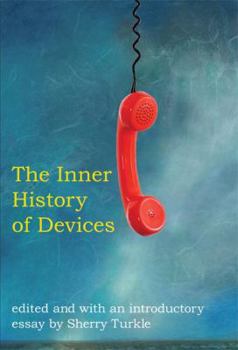The Inner History of Devices
Select Format
Select Condition 
Book Overview
For more than two decades, in such landmark studies as The Second Self and Life on the Screen, Sherry Turkle has challenged our collective imagination with her insights about how technology enters our private worlds. In The Inner History of Devices, she describes her process, an approach that reveals how what we make is woven into our ways of seeing ourselves. She brings together three traditions of listening--that of the memoirist, the clinician,...
Format:Hardcover
Language:English
ISBN:0262201763
ISBN13:9780262201766
Release Date:January 2008
Publisher:MIT Press (MA)
Length:208 Pages
Weight:0.95 lbs.
Dimensions:0.7" x 6.6" x 8.3"
Customer Reviews
1 rating
When a Device is Much More than just a Device
Published by Thriftbooks.com User , 15 years ago
Book Review submitted by: Stephen J. Hage, [email protected] This is a book that invites you to reexamine not only what you think of every day devices and things like cell phones, personal computers, computer games and implanted defibrillators; it asks you reexamine how you think about them and why. The approach is interesting in that uses ethnography, memoir and clinical cases in the form of essays written by individuals who've interacted with and, in some cases treated people who established relationships with devices most of us would never consider and not be able to see, even if we were to interact with those described in the essays. One I found particularly thought provoking is entitled: The Internal Cardiac Defibrillator An internal cardiac defibrillator is a device implanted in your chest and connected by wires to your heart. It constantly monitors your heartbeat and if your heart goes into cardiac fibrillation, which is life threatening, the device shocks you, much the same as depicted in scenes on medical shows like ER. But, instead of a doctor or EMT placing paddles on your chest, yelling "Clear" and pushing the button to shock you it happens automatically, inside your chest. The ICD shocks you and, when it does, the experience is as painful and traumatic as when it's done with paddles. It's impossible to understand what it means to have an ICD implanted in your chest without talking to people who do have one. Here's an example: "I died and then..." "This is the peculiar grammar of stories told by people with ICDs. The internal firing of the ICD is painful and brings one back from death, a repeated boundary crossing that writes a new narrative of life and death." On one level, having an ICD is comforting because it's there, just in case you need it to save your life. But, there's also a dark side. "My independence was gone. And yet, they say that this thing gives you more independence. Because you can be assured that you won't go into cardiac arrest and die when you take a trip and all that. My thing is, we take a trip, and I'm wondering, okay, I wonder which one of these exits is a hospital. Or, you know, something like that." Darker still is the story of Stan who is forty-two and received an ICD when he passed out while running. When he thinks back to that event, he realizes if he had died it would have been an easy death. "Like blacking out on the road, dying like that would be nothing. There would no pain whatsoever..." Now that particular option is gone. Should he go into cardiac arrest the ICD will shock him back to life. On one occasion he received multiple shocks while swimming. He felt a funny feeling in his chest that made him stop. "And all of a sudden, wham, I got shocked--damn, I gotta get out of the pool." He was shocked about three times. After the incident Stan asked his doctor how many times the ICD would shock him before it "would stop trying." About nine times his doctor told him. T





